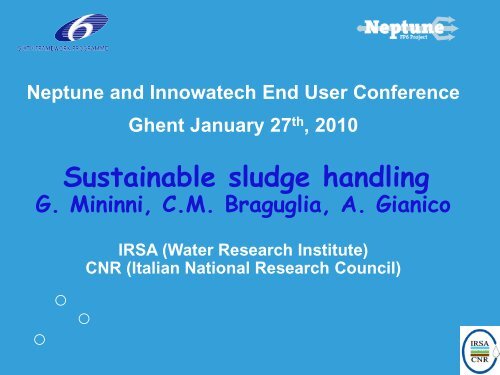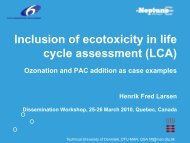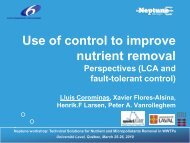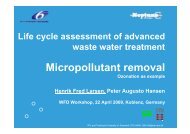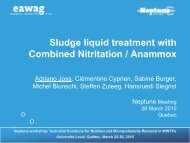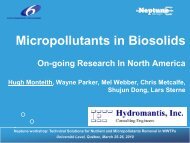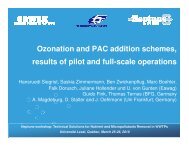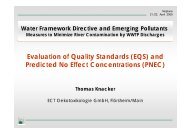Sustainable sludge handling - EU Project Neptune
Sustainable sludge handling - EU Project Neptune
Sustainable sludge handling - EU Project Neptune
You also want an ePaper? Increase the reach of your titles
YUMPU automatically turns print PDFs into web optimized ePapers that Google loves.
<strong>Neptune</strong> and Innowatech End User Conference<br />
Ghent January 27 th , 2010<br />
<strong>Sustainable</strong> <strong>sludge</strong> <strong>handling</strong><br />
G. Mininni, C.M. Braguglia, A. Gianico<br />
IRSA (Water Research Institute)<br />
CNR (Italian National Research Council)
The problem<br />
In the coming years it is expected that in Europe, at least for large wastewater<br />
treatment plants (WWTPs), the only possible solution for <strong>sludge</strong> disposal will be<br />
transforming <strong>sludge</strong> into inert material by thermal processes.<br />
The present European landfill Directive 99/31 has restricted this disposal route,<br />
which was practically abandoned in those countries where the implementation<br />
of the above criteria in national legislations was very stringent (a limit of the<br />
organic carbon to 4-5 % in the wastes to be disposed off is fixed).<br />
Guidelines for agricultural utilisation will become progressively more stringent<br />
due to increasing health concerns about the widespread diffusion of pathogen<br />
and organic micropollutants in the environment (European Commission, 2000).<br />
Agricultural utilisation involving large amounts of <strong>sludge</strong> to be spread on land<br />
does not seem feasible for the following reasons:<br />
need of large extensions of fields and therefore long distances to be covered from<br />
WWTPs to the site of spreading;<br />
need of large storage volume required when <strong>sludge</strong> cannot be used (winter periods<br />
and when the fields are flooded);<br />
large WWTPs are often polluted by non controlled industrial discharges that might<br />
hinder agricultural utilisation of resulting <strong>sludge</strong>.<br />
<strong>Neptune</strong> project, contract no 036845, FP6-2005-Global-4, SUSTDEV-2005-3.II.3.2 2
The problem<br />
The volume of the <strong>sludge</strong> extracted from primary and secondary settling tanks is<br />
about 2% of the volume of treated wastewater (WW) but its treatment and<br />
disposal entails very high capital and operating costs, which can be accounted as<br />
high as 50% of the total costs of the WW treatment plant, i.e. 25-35 €/(person ×<br />
year).<br />
Typical treatments for a large WW treatment plant include a first phase of<br />
concentration, generally carried out by gravity thickening, a biological aerobic or<br />
anaerobic stabilization, aimed to reduce biodegradable solids, odours and<br />
pathogens, and mechanical dewatering by centrifugation, belt-pressing or filterpressing.<br />
Often <strong>sludge</strong> processing is designed according to conventional systems, which<br />
might not be suitable for producing <strong>sludge</strong> with proper characteristics for the final<br />
outlet according to the legislative standards and avoiding any detrimental effects<br />
for the environment and any risk for the human health.<br />
According to the European Water Supply and Sanitation Technology Platform<br />
(WSSTP) in the large majority of cases, soil is, regardless of the technology or<br />
methodology selected, the final destination of vast quantities of treated <strong>sludge</strong>.<br />
<strong>Neptune</strong> project, contract no 036845, FP6-2005-Global-4, SUSTDEV-2005-3.II.3.2 3
European<br />
Union<br />
Landfill<br />
sites<br />
Current disposal options in Europe<br />
(% of <strong>sludge</strong> produced)<br />
Thermal treatments Composting Agricultural<br />
utilisation<br />
No agriculture<br />
18 23 7 45 7<br />
Austria 35 50 15<br />
Bulgaria 100 Some<br />
cases<br />
Czech<br />
Republic<br />
13
Per capita <strong>sludge</strong> production<br />
g/(person × d)<br />
Sludge production g/(person × d)<br />
Austria 55<br />
Brazil 33<br />
Canada 76<br />
Italy 38<br />
Finland 94<br />
Hungary 48<br />
Portugal 60<br />
Slovenia 20<br />
Turkey 60<br />
Medium value 54<br />
<strong>Neptune</strong> project, contract no 036845, FP6-2005-Global-4, SUSTDEV-2005-3.II.3.2 5
Towards a more sustainable<br />
sewage <strong>sludge</strong> management<br />
A more sustainable sewage <strong>sludge</strong> management could be attained through a<br />
separation of primary and secondary <strong>sludge</strong> before their treatment and disposal. It<br />
would thus be possible to maintain agricultural utilisation for the biological <strong>sludge</strong><br />
(secondary) and to convert to inert material by incineration (on-site or off-site) only<br />
the primary <strong>sludge</strong> (Mininni et al. 2004).<br />
Characteristics of primary and secondary <strong>sludge</strong> are quite different in terms of<br />
quality (pollutants and nutrients) and in terms of suitability for thickening, digestion<br />
and dewatering. Secondary <strong>sludge</strong> is expected to be less polluted than primary<br />
<strong>sludge</strong>, and should be segregated and treated separately from primary <strong>sludge</strong><br />
thus sustaining its agricultural utilisation.<br />
Sludge separation may also give flexibility to <strong>sludge</strong> management, decreasing<br />
dependency on conventional disposal options (as required in the European<br />
Directive 2008/98) as <strong>sludge</strong> of good quality (biosolids) can be recovered for<br />
agricultural utilisation while the remaining primary <strong>sludge</strong> can be treated by<br />
thermal treatments. The challenge in the coming years will be, in fact, assuring in<br />
<strong>sludge</strong> management the greatest flexibility, maximizing recovery of valuable<br />
products and energy sources and reducing disposal only to inert materials which<br />
cannot be recovered any more.<br />
<strong>Neptune</strong> project, contract no 036845, FP6-2005-Global-4, SUSTDEV-2005-3.II.3.2 6
10<br />
9<br />
8<br />
Assessment of primary and secondary<br />
<strong>sludge</strong> characteristics in the <strong>Neptune</strong> project<br />
(nutrients)<br />
Total Phosphorus<br />
Total Nitogen<br />
P=Primary <strong>sludge</strong><br />
S=Secondary <strong>sludge</strong><br />
Cobis<br />
Fregene<br />
P and N concentration (% of TS)<br />
7<br />
6<br />
5<br />
4<br />
3<br />
Roma Nord<br />
2<br />
1<br />
S<br />
P S P P S P S P S P S PS S<br />
0<br />
P S<br />
P<br />
S<br />
P<br />
S<br />
P<br />
S<br />
P<br />
S P<br />
P S S<br />
P<br />
S<br />
P<br />
<strong>Neptune</strong> project, contract no 036845, FP6-2005-Global-4, SUSTDEV-2005-3.II.3.2 7
Assessment of primary and secondary <strong>sludge</strong><br />
characteristics in the <strong>Neptune</strong> project (metals)<br />
10000<br />
1000<br />
Cd primary Cd secondary Hg primary Hg secondary<br />
As primary As secondary Ni primary Ni secondary<br />
Cr primary Cr secondary Pb primary Pb secondary<br />
Cu primary Cu secondary Mn primary Mn secondary<br />
Zn primary Zn secondary<br />
Concentration (mg/kg dry solid)<br />
100<br />
10<br />
1<br />
0,1<br />
0,01<br />
Roma Nord Cobis Fregene<br />
<strong>Neptune</strong> project, contract no 036845, FP6-2005-Global-4, SUSTDEV-2005-3.II.3.2 8
Assessment of primary and secondary<br />
<strong>sludge</strong> characteristics in the <strong>Neptune</strong> project<br />
(organic micropollutants)<br />
40.000<br />
35.000<br />
Cobis<br />
PRIMARY<br />
SECONDARY<br />
30.000<br />
Concentration<br />
25.000<br />
20.000<br />
15.000<br />
Rome Nord<br />
Fregene<br />
Cobis<br />
10.000<br />
Rome Nord<br />
Fregene<br />
5.000<br />
Rome Nord<br />
Cobis<br />
Fregene<br />
0<br />
EOX<br />
(µg Cl/kg TS)<br />
MBAS<br />
(mg/kg TS)<br />
Total hydrocarbons<br />
C10-C40 (mg/kg TS)<br />
<strong>Neptune</strong> project, contract no 036845, FP6-2005-Global-4, SUSTDEV-2005-3.II.3.2 9
Secondary <strong>sludge</strong> disintegration<br />
One of the main goals in secondary <strong>sludge</strong> processing is improving the<br />
performance of the anaerobic digestion.<br />
Secondary <strong>sludge</strong> contains up to 70% of bacteria which can be resistant<br />
to anaerobic digestion.<br />
Acceleration of the process can be achieved by increasing the hydrolysis,<br />
which is the limiting step of the whole anaerobic process.<br />
Sludge disintegration treatments are able to disrupt biomass flocs and cell<br />
walls and to cause the release of the intracellular organic material. The<br />
subsequent increase in biodegradable material improves bacterial<br />
kinetics resulting in lower <strong>sludge</strong> quantities and, in the case of anaerobic<br />
digestion, increased biogas production.<br />
The most common methods for <strong>sludge</strong> disintegration are based on the<br />
use of ultrasounds (mechanical disintegration) at an energy input of 1-2<br />
kWh/kg dry solids or on thermal disintegration at temperature of 170°C<br />
and 8.5 bar (Cambi process) or at 150-180°C and 8-10 bar (Biothelys<br />
process).<br />
<strong>Neptune</strong> project, contract no 036845, FP6-2005-Global-4, SUSTDEV-2005-3.II.3.2 10
Process flow sheets with <strong>sludge</strong><br />
triage<br />
Energy<br />
(heat)<br />
amount,<br />
composition,<br />
environmental<br />
impact<br />
Produced gas<br />
I<br />
E<br />
Primary <strong>sludge</strong><br />
G<br />
Drying-Incineration<br />
with internal energy<br />
recovery<br />
Primary<br />
settling<br />
A<br />
Gravity<br />
thickening<br />
B<br />
Anaerobic<br />
digestion<br />
D<br />
Dewatering<br />
Chemicals, Energy<br />
F<br />
C<br />
Off gas<br />
L<br />
On-site drying<br />
Energy<br />
H<br />
Q<br />
Energy (transport)<br />
M<br />
Biological<br />
treatment<br />
WAS<br />
P<br />
Dynamic<br />
thickening<br />
Energy<br />
Effluent for<br />
further<br />
treatment<br />
amount, composition, disposal<br />
(heavy metals, icropollutants)<br />
Produced gas<br />
O<br />
Off-site<br />
coincineration<br />
R<br />
Energy (aeration)<br />
Chemicals (foam<br />
breakers?)<br />
Short aerobic<br />
thermophilic treatment<br />
with intermittent feed (5d;<br />
45°C)<br />
Ultrasound<br />
disintegration +<br />
anaerobic digestion<br />
Energy<br />
Thermal<br />
disintegration +<br />
anaerobic<br />
digestion<br />
Energy<br />
S<br />
Produced biogas to<br />
energy production<br />
U<br />
T<br />
Produced biogas to<br />
energy production<br />
W<br />
Chemicals<br />
Energy<br />
Dewatering<br />
V<br />
AA<br />
Chemicals<br />
Energy<br />
AB<br />
Dewatering<br />
X<br />
Chemicals<br />
Energy<br />
AC<br />
Dewatering<br />
Energy<br />
(transport)<br />
Y<br />
Z<br />
Energy<br />
(transport)<br />
Energy<br />
(transport)<br />
Sludge to agriculture<br />
nutrients<br />
(e.g. N, P)<br />
J<br />
amount, treatment,<br />
composition, disposal<br />
Solid<br />
residue<br />
K<br />
Fuel<br />
N<br />
<strong>Neptune</strong> project, contract no 036845, FP6-2005-Global-4, SUSTDEV-2005-3.II.3.2 11
Process flow sheets without<br />
<strong>sludge</strong> triage<br />
Primary<br />
settling<br />
Biological<br />
treatment<br />
Effluent for further treatment<br />
Primary<br />
<strong>sludge</strong><br />
Sludge<br />
liquid<br />
C<br />
Sludge liquid<br />
A<br />
WAS<br />
Thickening<br />
B<br />
Mesophilic<br />
anaerobic<br />
digestion (37°C)<br />
G<br />
D<br />
F<br />
amount, composition,<br />
disposal<br />
Off gas<br />
H<br />
On-site thermal<br />
drying-incineration<br />
Chemicals,<br />
Energy<br />
No fuel is needed<br />
E<br />
P<br />
Mechanical<br />
dewatering<br />
amount, treatment,<br />
composition, disposal<br />
E<br />
Solid<br />
residue<br />
or<br />
P<br />
amount, composition,<br />
disposal<br />
Off gas<br />
Energy<br />
Off-site<br />
coincineration<br />
L<br />
O<br />
On-site drying<br />
N<br />
Fuel<br />
Energy (transport of<br />
dryed <strong>sludge</strong>; 90% DS)<br />
M<br />
Off gas<br />
Produced biogas to energy production<br />
<strong>Neptune</strong> project, contract no 036845, FP6-2005-Global-4, SUSTDEV-2005-3.II.3.2 12
Flow sheet for <strong>sludge</strong> incineration<br />
<strong>Neptune</strong> project, contract no 036845, FP6-2005-Global-4, SUSTDEV-2005-3.II.3.2 13
100<br />
Results with <strong>sludge</strong> triage<br />
COD SS VSS Total mass<br />
Total mass of primary+secondary <strong>sludge</strong>=16,27 (before treatment), 0,614 kg/m 3 WW (after treatment)<br />
Mass of dry solids=0,282 (before treatment), 0,152 kg/m 3 WW (after treatment)<br />
10<br />
12,3<br />
kg/m 3 WW<br />
3,97<br />
1<br />
Primary <strong>sludge</strong><br />
0,363<br />
Secondary <strong>sludge</strong><br />
0,159<br />
0,1<br />
0,0924<br />
0,123<br />
0,251<br />
0,0602<br />
0,01<br />
A Before thickening<br />
B After thickening<br />
D After digestion<br />
F After dewatering<br />
M After drying<br />
P Before thickening<br />
R After dynamic thickening<br />
S After short aerobic<br />
thermophilic digestion<br />
T After US dis. and<br />
digestion<br />
V After therm. dis. and<br />
digestion<br />
Y Sludge T after dewatering<br />
X Sludge S after dewatering<br />
Z Sludge V after dewatering<br />
<strong>Neptune</strong> project, contract no 036845, FP6-2005-Global-4, SUSTDEV-2005-3.II.3.2 14
Results without <strong>sludge</strong> triage<br />
100<br />
COD SS VSS Total mass<br />
16,24<br />
10<br />
kg/m 3 WW<br />
1<br />
0,281<br />
0,724<br />
0,161<br />
0,1<br />
0,01<br />
A Sludge before<br />
thickening<br />
B Thickened<br />
<strong>sludge</strong><br />
D Digested<br />
<strong>sludge</strong><br />
E Dewatered<br />
<strong>sludge</strong><br />
L Dried <strong>sludge</strong><br />
<strong>Neptune</strong> project, contract no 036845, FP6-2005-Global-4, SUSTDEV-2005-3.II.3.2 15
70<br />
Net biogas production<br />
Biogas<br />
60<br />
H 2 O<br />
CH4 CO2 H2O<br />
50<br />
H 2 O<br />
CO 2<br />
CO 2<br />
CO 2<br />
CO 2<br />
L/m 3 WW<br />
40<br />
30<br />
H 2 O<br />
20<br />
23.8<br />
20.8<br />
H 2 O<br />
10<br />
CH 4<br />
CH 4<br />
CH 4 CH 4<br />
10.9<br />
13.5<br />
0<br />
Mixed<br />
<strong>sludge</strong><br />
Primary<br />
<strong>sludge</strong><br />
Secondary <strong>sludge</strong><br />
after ultrasound<br />
disintegration<br />
Secondary <strong>sludge</strong><br />
after thermal<br />
disintegration<br />
<strong>Neptune</strong> project, contract no 036845, FP6-2005-Global-4, SUSTDEV-2005-3.II.3.2 16
Off gas from thermal treatments<br />
9<br />
CO2 H2O N2 O2<br />
Off gas production (Nm 3 /m 3 WW)<br />
8<br />
7<br />
6<br />
5<br />
4<br />
3<br />
2<br />
1<br />
1.12<br />
7.54<br />
MS=Mixed <strong>sludge</strong><br />
PS=Primary <strong>sludge</strong><br />
1.35<br />
0.598<br />
3.63<br />
0.789<br />
0<br />
On-site<br />
incineration<br />
MS<br />
On-site<br />
drying<br />
MS<br />
Off-site<br />
incineration<br />
dryed MS<br />
On-site<br />
incineration<br />
PS<br />
On-site<br />
drying<br />
PS<br />
Off-site<br />
incineration<br />
dryed PS<br />
<strong>Neptune</strong> project, contract no 036845, FP6-2005-Global-4, SUSTDEV-2005-3.II.3.2 17
Sludge triage allows:<br />
<br />
<br />
<br />
Conclusions<br />
reducing the production of primary + secondary <strong>sludge</strong> with respect to conventional treatment,<br />
considering that secondary <strong>sludge</strong> can be appropriately treated by dynamic thickening, disintegration<br />
and digestion, thus reducing considerably both the water content and the biodegradable solids;<br />
reducing disposal problems only to primary <strong>sludge</strong>. To this purpose an integrated incineration<br />
process can be used thus minimizing the exhaust gas production to such low values (for a WWTP<br />
serving 500.000 PE 3.100 Nm 3 /h for primary <strong>sludge</strong> comparing to 5.800 Nm 3 /h for mixed <strong>sludge</strong>)<br />
that these type of plant can be considered like a pilot plant;<br />
giving more flexibility to <strong>sludge</strong> management considering that disposal of <strong>sludge</strong> is not accomplished<br />
by a unique solution.<br />
Sludge incineration should be preferentially performed with an on-site plant. The<br />
use of external incineration or co-incineration plants is not convenient whether the<br />
<strong>sludge</strong> has to be previously dried. In fact, the methane requirement for on-site<br />
thermal drying (34.4 and 71.7 L/m 3 WW, for primary and mixed <strong>sludge</strong><br />
respectively) if no other waste heat is available, would be scarcely compensated<br />
by the biogas production from digestion only with flow sheet with <strong>sludge</strong> triage.<br />
With the conventional flow sheet energy requirement for <strong>sludge</strong> drying is much<br />
higher than the available energy with biogas. This option is not environmental<br />
friendly also considering the quite high amount of total gaseous effluent produced<br />
in drying and incineration (23.000-46.300 Nm 3 /h for primary and mixed <strong>sludge</strong>,<br />
respectively, for a plant serving 500.000 PE).<br />
<strong>Neptune</strong> project, contract no 036845, FP6-2005-Global-4, SUSTDEV-2005-3.II.3.2 18
Acknowledgment<br />
• This study was part of the <strong>EU</strong> <strong>Neptune</strong> project (Contract No<br />
036845, SUSTDEV-2005-3.II.3.2), which was financially<br />
supported by grants obtained from the <strong>EU</strong> Commission within<br />
the Energy, Global Change and Ecosystems Program of the<br />
Sixth Framework (FP6-2005-Global-4)<br />
<strong>Neptune</strong> project, contract no 036845, FP6-2005-Global-4, SUSTDEV-2005-3.II.3.2 19


